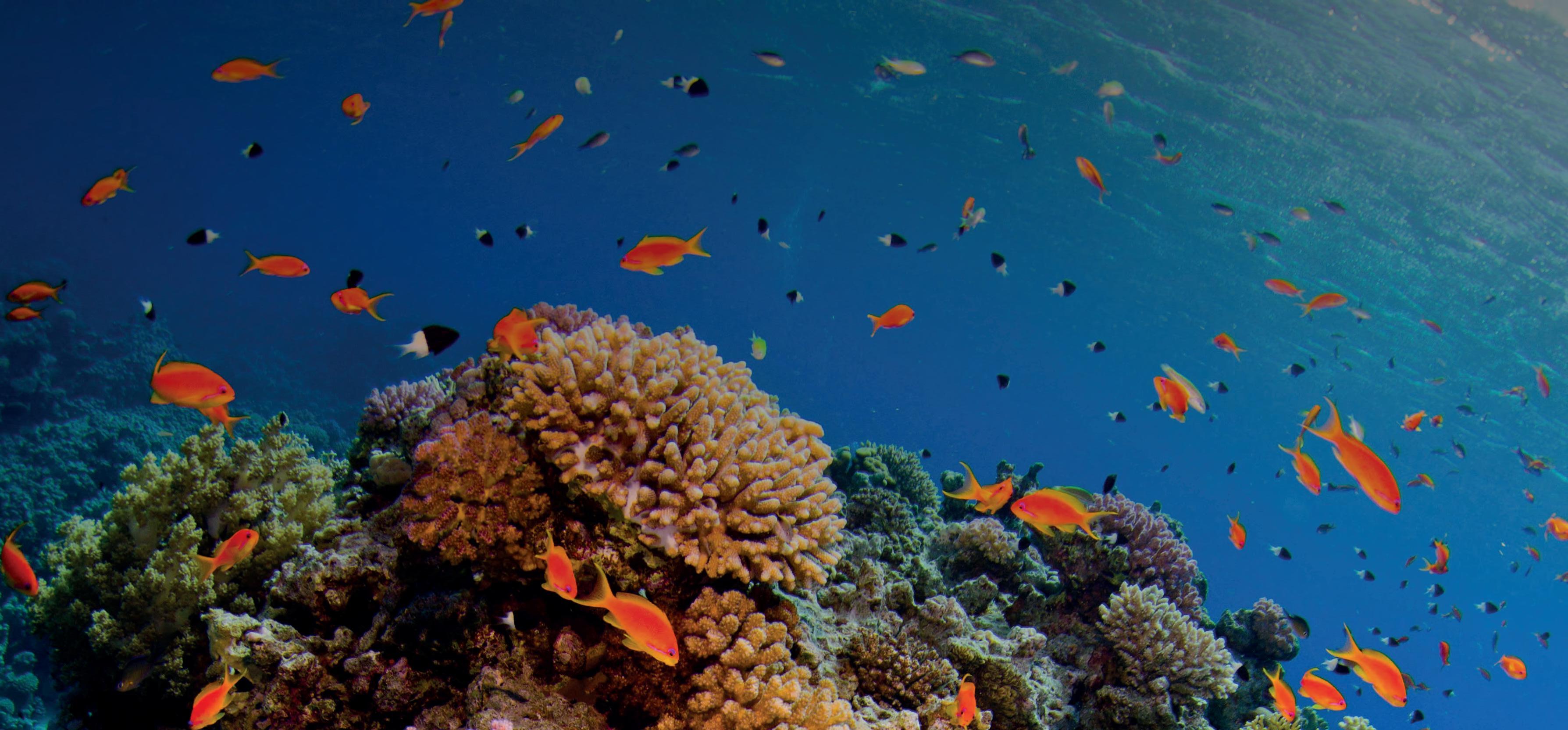



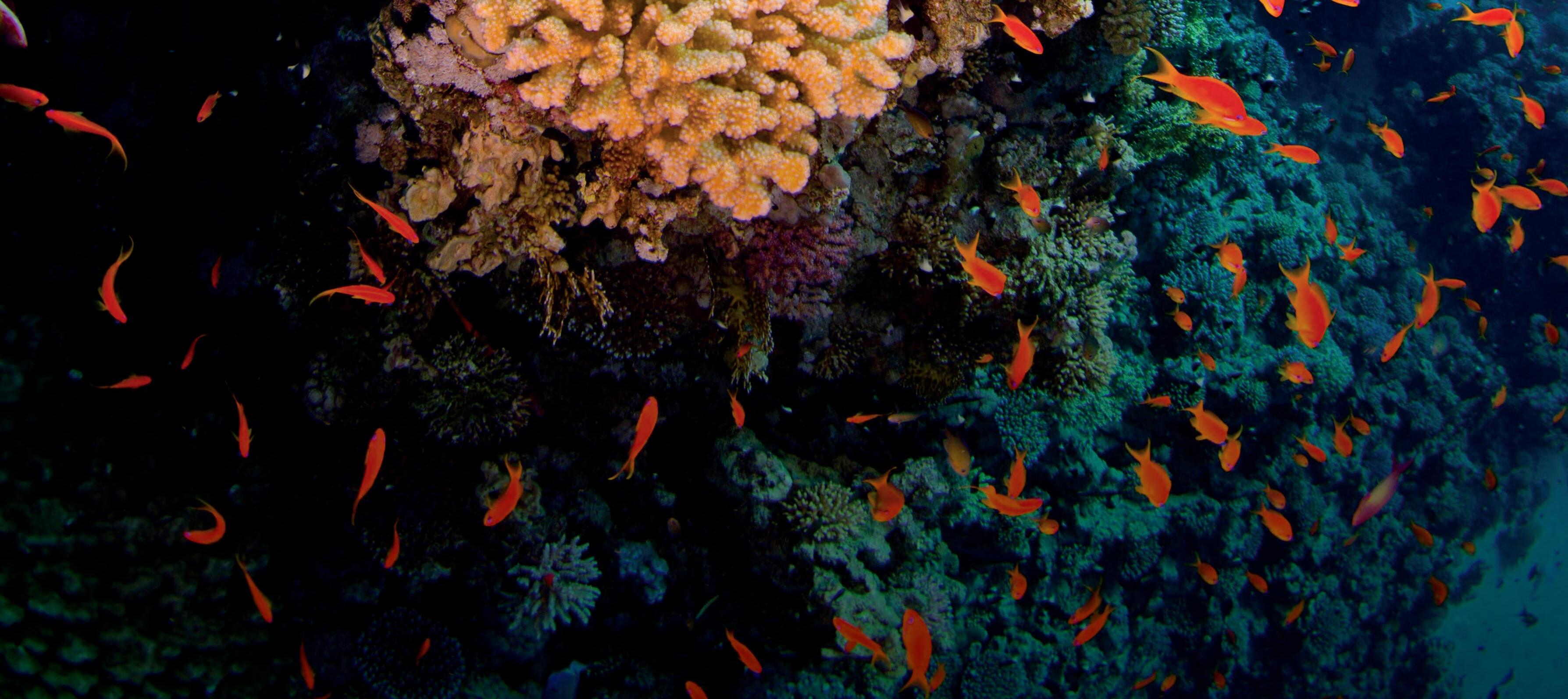
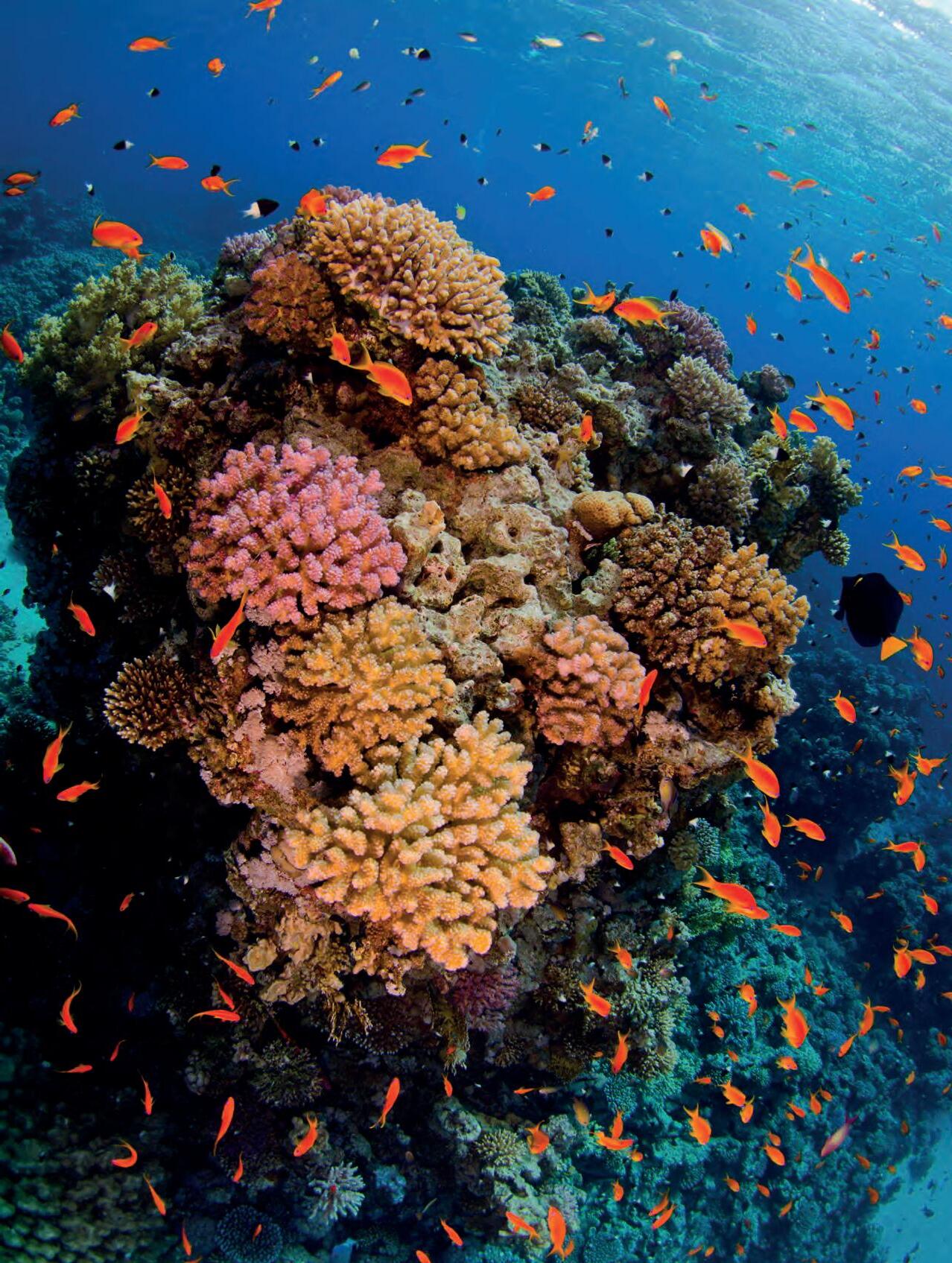
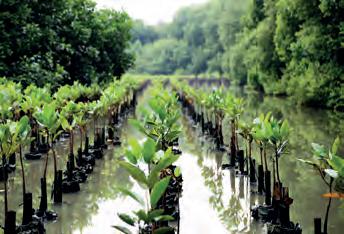


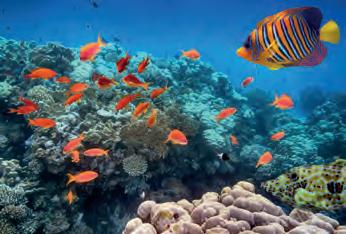

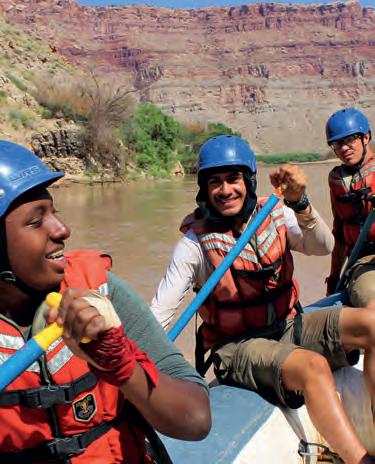



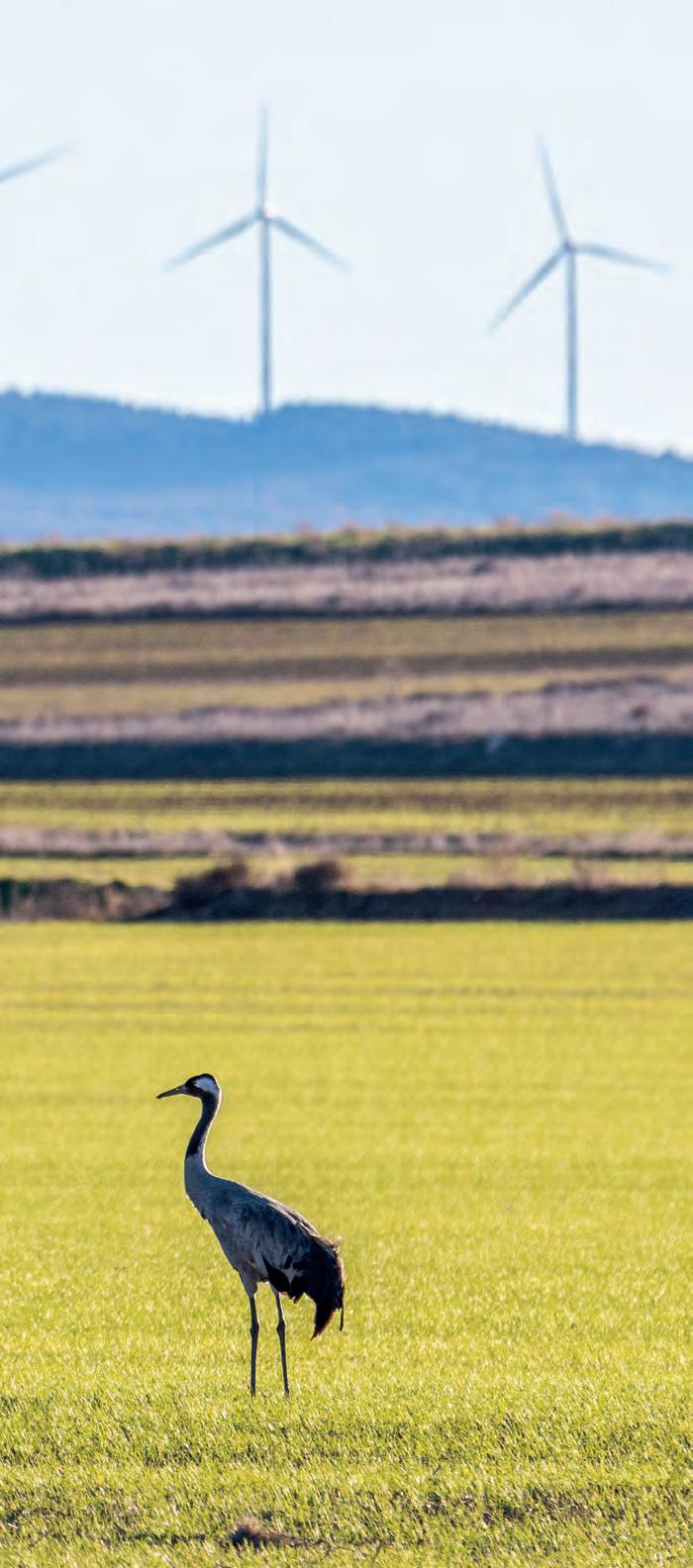




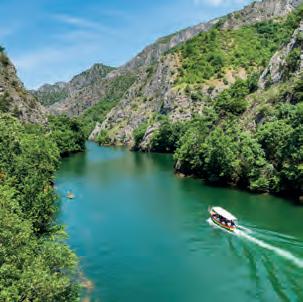

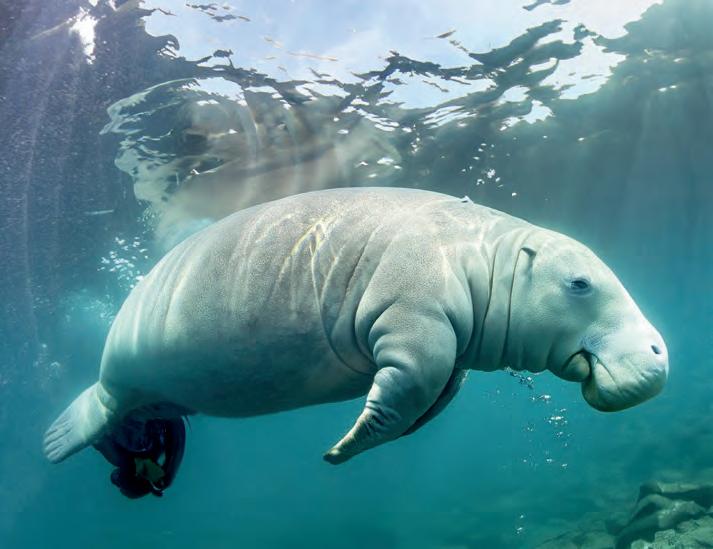




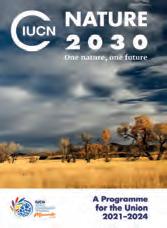
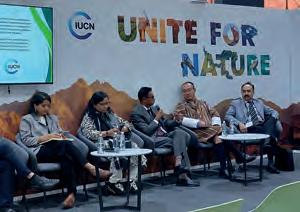



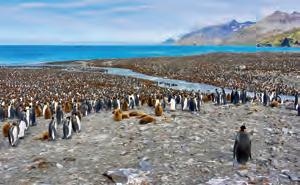
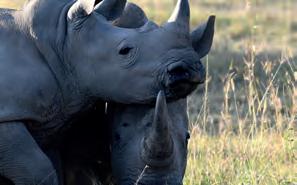


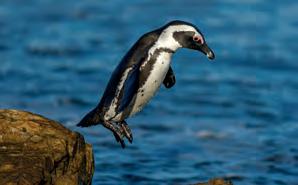


















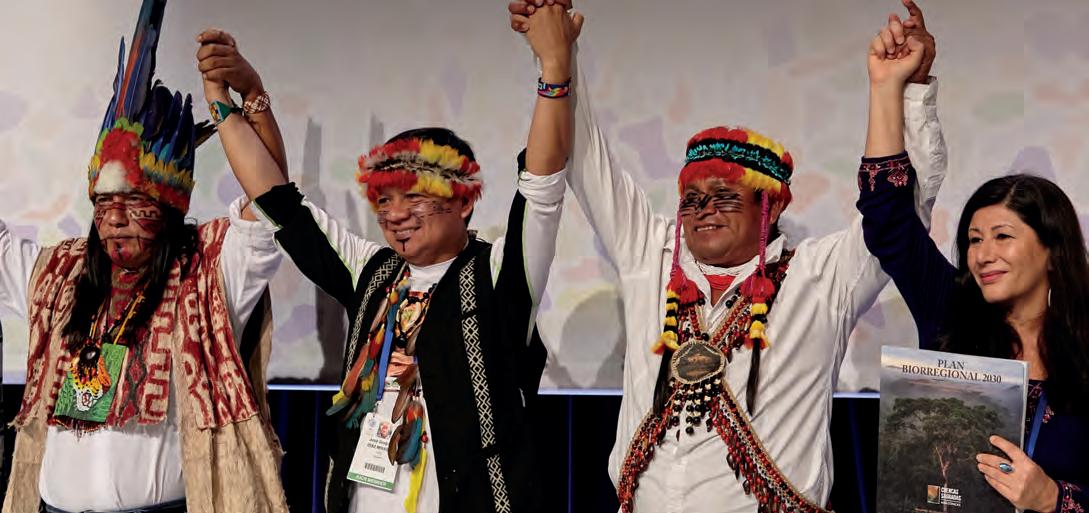
















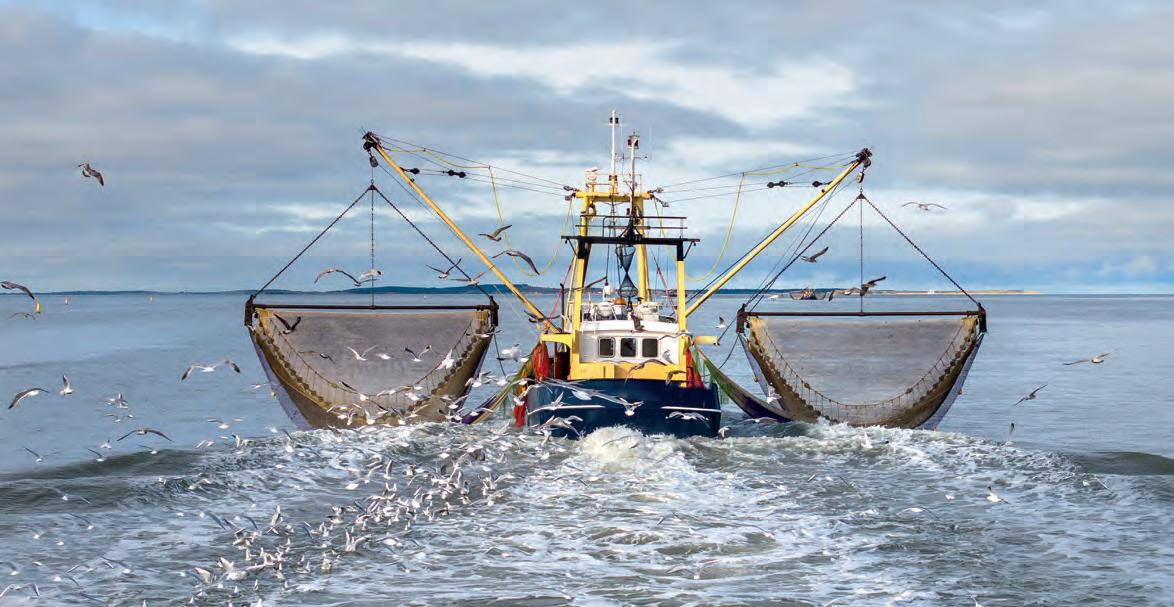




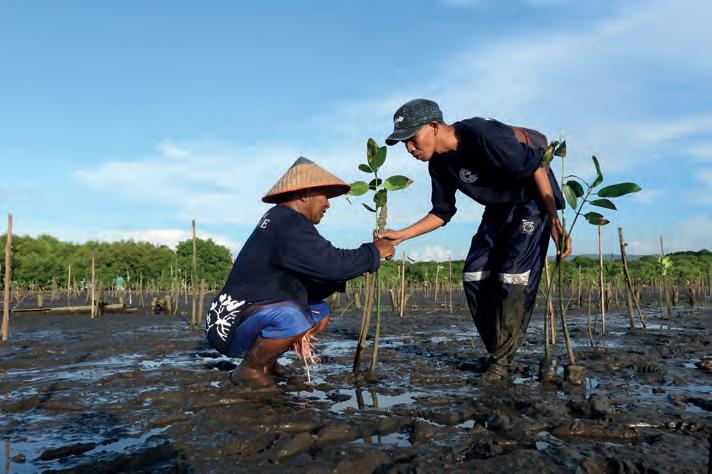






























































































Life on a coral reef is fast and everchanging. A grumpy grouper swims by with a fishing hook in its lip, a green turtle drifts along on the current, and bright orange reef fish flutter like flames around the brown, red and purple corals of all shapes and sizes. More than a quarter of all marine fish species rely on coral reefs. They are home to the highest biodiversity of any ecosystem in the world.
These bustling ecosystems are important for us, too. “Protecting reefs is protecting people,” says María José González, executive director of the Mesoamerican Reef Fund (MAR Fund), a Guatamela-based non-governmental organisation and an IUCN Member. “A healthy reef means stronger economies, safer shorelines and thriving marine life,” González explains. “Coral reefs act as storm barriers, reducing wave energy by
up to 97% and protecting coastal communities from erosion and flooding.”
But corals are in trouble. “It will take decades to reverse the increase we are seeing in sea surface temperatures,” says Beth Polidoro, an Associate Professor at Arizona State University and Red List Coordinator for the IUCN Species Survival Commission (SSC) Coral Specialist Group “In other words, if we cut all our emissions today, our current models are
“WE CAN GIVE CORALS A FIGHTING CHANCE BY REDUCING LOCAL THREATS”

predicting that sea surface temperatures will continue to increase until about 2050–2070,” she says. “That’s not great news for corals.”
Co-chaired by Francoise Cavada Blanco and David Obura, the IUCN SSC Coral Specialist Group brings together over 120 coral experts to ensure policymakers base marine management decisions and
Nature Seychelles, Mahé, Seychelles
Nature Seychelles’ Reef Rescuers coral reef restoration project aims to tackle climate change-induced bleaching. Through its ocean nurseries, the project has raised over 90,000 coral fragments and transplanted 9500 m² of degraded reef. They have also introduced the micro-fragmentation technique for restoration in a land-based nursery. Through the IUCN-Huawei Tech4Nature project, Nature Seychelles has worked with local companies to pioneer locallymade ocean conservation technology.
Coral Triangle Center (CTC), Indonesia CTC promotes marine conservation and the sustainable use of coastal resources across the Coral Triangle. Alongside Mars Incorporated and Nusa Dua Reef Foundation, CTC is building capacity for reef restoration and resilience-based management in Marine Protected Areas across Indonesia, through its Coral Reef Restoration Task Force.
Oceans Alive Trust, Kenya
An IUCN Member, Oceans Alive focuses on working collaboratively with the communities that rely on the ocean to manage marine areas in a sustainable way. One great example of this integrated approach is Kenya’s first co-managed area plan, which put
conservation actions on robust science. In November 2024, their global assessment of the world’s 892 known reef-building species revealed that 44% of warm-water corals now face an elevated risk of extinction (up from a third in 2008). The main threat is climate change and warming sea surface temperatures.
Corals’ resistance to warming waters is related to local threats. Those already struggling with the impacts of pollution, habitat loss, disease or an outbreak of predatory crown-of-thorns sea stars are more vulnerable. Corals that aren’t bombarded by these threats may have more resilience and be better able to adapt. More resilient species (some Red Sea corals can tolerate a 7°C increase) could hold the key to helping reefs survive as temperatures continue to climb.
IUCN’s assessments gather data on which species are more vulnerable to threats. “Now we know exactly which geographic regions have a higher
150 km² under community-led management in 2022.
Hawai’i Conservation Alliance, Hawai’i
A partnership of organisations and agencies, Hawai’i Conservation Alliance is working to increase conservation literacy and build capacity among local stakeholders. Through its support for community-led conservation activities, the Alliance is increasing support for the management of Hawai’i’s ecosystems.
Great Barrier Reef Marine Park Authority, Australia
Australia’s lead management agency for the Great Barrier Reef works with traditional owners, other government agencies, industry and community to protect and manage the reef. Every five years, they publish an Outlook Report examining the Great Barrier Reef’s health, pressures and likely future.
Mesoamerican Reef Fund, Guatemala
“As an IUCN Member, MAR Fund gains access to cutting-edge scientific research, policy advocacy and global conservation strategies,” says MAR’s María José González. “This strengthens our ability to implement innovative solutions for reef resilience, ensuring long-term protection for the MAR and the communities that depend on it.”
proportion of either vulnerable or more resilient coral species,” says Polidoro. “This information can help target and prioritise more effective conservation action and policy.”
IUCN’s SSC Coral Specialist Group network of over 120 assessors from more than 30 countries “now have the data, tools and knowledge to implement targeted conservation actions within their respective regions”, she says.
IUCN Members and partners are taking action for coral reefs in their own nations, too. “We can give corals a fighting chance by reducing the local threats that contribute to increased vulnerability,” says Polidoro. Preventing nutrient runoff, stopping destructive fishing practices – like dynamite, cyanide and dredging –and overharvesting in reefs, as well as creating effective marine protected areas can all help corals thrive.

1. UN Ocean Conference (UNOC3)
Conservationists from around the world gathered in Nice for the 3rd UN Ocean Conference (28 May –13 June), co-hosted by Costa Rica and France.
2. One Ocean Science Congress
A special UNOC3 event dedicated to science, this took place in Nice from 4–6 June, bringing together more than 2,000 international scientists to identify innovative indicators and solutions for ocean health.
3. Blue Economy & Finance Forum (BEFF)
As part of UNOC, BEFF in Monaco (7–8 June) – opened by IUCN Patron for Nature HSH Albert II, Prince of Monaco – focused on how to create a regenerative and sustainable ocean economy.
4. Status of Coral Reefs report
The Global Coral Reef Monitoring Network is collecting data for its Status of Coral Reefs of the World 2025 report, to be released in 2026.
“Local capacity building is key,” says González. “The Post-Storm Reef Response Brigades in the Mesoamerican Reef are ready to act immediately after hurricanes. ”When a severe storm hits, these trained teams spring into action to give corals the best chance of recovery. “They do damage assessment, debris removal, coral reattachment and emergency coral stabilisation, among other actions,” she says.
Access to funding is vital. “The MAR parametric insurance provides fast, pre-agreed payouts based on hurricane intensity and distance of coral reefs from the hurricane track, ensuring rapid funding for reef response,” adds González. “This minimises economic losses and helps reefs recover before long-term damage sets in.”
“AS AN IUCN MEMBER, MAR FUND GAINS ACCESS TO CUTTING-EDGE SCIENTIFIC RESEARCH, POLICY ADVOCACY AND GLOBAL
Advances in technology also contribute. In January 2025, Huawei, IUCN and Kenya Wildlife Service announced a three-year Tech4Nature project using underwater cameras, photogrammetry, audio monitoring and artificial intelligence to keep an eye (and ear) on reefs. The data generated will help ensure conservation measures are targeted and effective.
Each year, more than 350 million tourists visit coastlines around the world with coral reefs. These travellers (and their spending power) can also create a powerful force for good. The estimated value of coral reef tourism is around US$36bn annually.
The Great Barrier Reef Marine Park Authority (GBRMPA) in Queensland, Australia, has recognised this potential. Its Tourism Reef Protection Initiative funded 26 operators to support reef health monitoring, pest control, coral gardening and controlling pests like crown-of-thorns starfish. Through a programme called Master Reef Guides, GBRMPA also trains tourism guides to become ambassadors for the Great Barrier Reef.
Minna Epps, Director of IUCN’s Global Ocean Policy, has described the goal of protecting 30% of our ocean by 2030, as

set down in the UN’s Global Biodiversity Framework, as a “monumental task impossible to achieve without a High Seas Treaty”.
“With only five years left and currently only 3% of the ocean free from human disturbance, and approximately 8% of the ocean protected, the urgency for innovative solutions, including innovative financial mechanisms, has never been greater,” she commented recently.
One challenge for successfully protecting 30% of the ocean is the fact that the High Seas Treaty (the Biodiversity Beyond National Jurisdictions Agreement) hinges on 60 ratifications before its entry into force.
“In total, 64% of the ocean is beyond national jurisdiction or the Economic Exclusive Zones of states – that is the high seas,” Epps says. “Up until now, it hasn’t been completely lawless, but the legal framework has been very fragmented, with many governance bodies and no
IUCN Member MAR Fund is dedicated to protecting the Mesoamerican Reef of Mexico, Guatemala, Honduras and Belize

legal framework for establishing Marine Protected Areas on the high seas.” With only 1% of the high seas protected, it is high time for the high seas.
Although corals are often found in shallow coastal areas, a 2020 study identified 116 reefs in the high seas. When the High Seas Treaty enters into force, it will allow nations to work together to establish Marine Protected Areas, conduct environmental impact assessments and build capacity for conservation efforts – all of which could benefit corals. IUCN is collaborating with the Coral Reefs of the High Seas Coalition to generate the science, strategic communication and political support that is necessary to catalyse action.
The Treaty needs to be ratified by at least 60 countries for it to enter into force. At the time of writing, 115 states have signed the Treaty and 21 states have ratified it, with the Republic of Korea being the last country to do so and the EU expected in bulk at the end of May. It’s hoped that 60 States will have ratified by the Third UN Ocean Conference and that it will enter into force by the end of 2025.
Protecting coral reefs isn’t just the responsibility of marine scientists. That’s why the Global Fund for Coral Reefs, which partnered with IUCN in 2021 as an institutional partner and later an implementing partner, brings together UN agencies, financial

institutions, investors and conservation organisations. The public-private partnership supports reef protection through ocean-positive business pipelines, investment opportunities and innovative finance approaches, as well as education that influences investment and policy choices.
IUCN is one of over 100 members of the International Coral Reef Initiative (ICRI). As such, the Union supports ICRI’s work to protect, conserve and restore coral ecosystems; in particular, through strengthened monitoring and observation.
“With pivotal milestones on the horizon, including the UN Ocean Conference in Nice, we have a unique opportunity to unite our efforts and drive meaningful change,” says Epps.
“Together, we can ensure that all the voices of ocean advocates are heard, and we can make significant strides in preserving our precious marine ecosystems.”




























62nd Sessions of the UNFCCC Subsidiary Bodies
16-26 June
Bonn, Germany
The UNFCCC subsidiary bodies for Scientific and Technological Advice and for Implementation will convene in Bonn for their annual intersessional meetings. IUCN will contribute to discussions on mitigation and adaptation work programmes, the ocean and climate dialogue, and other key agenda items. unfccc.int
Open-ended Working Group (OEWG) and First Conference of the Global Framework for Chemicals
24-27 June
Punta del Este, Uruguay
IUCN will address efforts to
stop global plastic pollution in marine environments by 2030, eliminate plastic pollution in protected areas and promote regional approaches to marine debris. unep.org
4th International Conference on Financing for Development (FfD4)
30 June – 3 July
Seville, Spain
Held at the highest political level, FfD4 will outline negotiated outcomes and summarise key discussions in its final report. IUCN will focus on stopping global plastic pollution in marine environments by 2030, advancing ocean ecosystem conservation and restoration, and strengthening biodiversity financing. financing.desa.un.org/ffd4
47th Session of the World Heritage Committee 6-16 July
Paris, France
As the technical advisory body on natural World Heritage, IUCN is recommending five spectacular new listings, recommending action on over 75 sites facing threats and proposing changes to strengthen World Heritage and linked international designations, including on finance and inclusion of Indigenous Peoples. whc.unesco.org/en/ sessions/47COM
30th Session of the International Seabed Authority Assembly and Council (Part II) 7-25 July
Kingston, Jamaica
This session will include the
Bonn, Germany
meetings of the Legal and Technical Commission, the Finance Committee, the ISA Council and the ISA Assembly. IUCN will focus on reducing the mining industry’s impact on biodiversity, advocating for a moratorium on seabed mining and calling for the withdrawal of mining permits under the Wadden Sea. isa.org.jm/sessions/30thsession-2025
High-level Political Forum on Sustainable Development (HLPF) 2025 14-23 July
New York, USA
IUCN plans to send a delegation to the Forum, with recommendations including the transformation of global food systems through sustainable land management, cooperation on transboundary
freshwater ecosystems, and maximising the return on conservation investments by eradicating invasive alien species to protect island biodiversity. hlpf.un.org/2025
15th Meeting of the Conference of the Contracting Parties to the Ramsar Convention on Wetlands (COP15) 23-31 July
Victoria Falls, Zimbabwe
Every three years, representatives of the Contracting Parties meet to agree on a work programme, budget and guidance on environmental issues. IUCN will address protecting rivers as wildlife corridors, conserving natural water flows for wetland protection and advancing ecological connectivity conservation. ramsar.org/meetings
BBNJ PrepCom II
18-29 August
New York, USA
IUCN’s recommendations will include developing an effective Post-2020 Global Biodiversity Framework, protecting deep-ocean ecosystems through a moratorium on seabed mining and acting for the conservation and sustainable use of marine biodiversity in

areas beyond national jurisdiction.
sdg.iisd.org/events/bbnjprepcom-ii
UN General Assembly (UNGA) High-level Week 23-29 September
New York, USA
The 80th session of the UNGA 80 will officially begin in mid-September with the formal handover of the Presidency from the outgoing to the incoming President. Historically, IUCN

has actively participated in various events during Highlevel Week, and details of this year’s engagements will be finalised in due course. un.org/en
8th IUCN World Conservation Congress 9-15 October
Abu Dhabi, UAE
The IUCN Word Conservation Congress is the largest gathering of conservation experts, leaders and decisionmakers in the world. It will help shape global priorities for nature conservation and climate change for the coming decade and beyond. iucncongress2025.org
Annual Meeting for the Commission for the Conservation of Antarctic Living Marine Resources (CCAMLR) 20-31 October
Hobart, Australia
Established in 1982 to address krill overexploitation, the Commission for the
Conservation of Antarctic Marine Living Resources works to protect Antarctic marine ecosystems. IUCN will support this work, guided by its resolutions on reducing the impact of fisheries on marine biodiversity and achieving representative protected areas across Antarctica and the Southern Ocean. ccamlr.org
Minamata Convention COP-6 3-7 November
Geneva, Switzerland
The Minamata Convention addresses mercury persistent in the environment. IUCN champions key resolutions, including treating organised environmental crime as a serious offence, promoting sustainable and ethical mining practices in Africa, and calling for a moratorium on seabed mining to protect deep-ocean ecosystems and biodiversity. minamataconvention.org
















































































